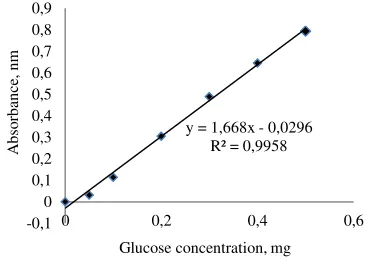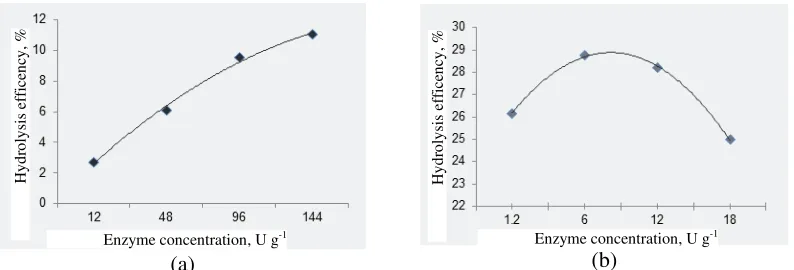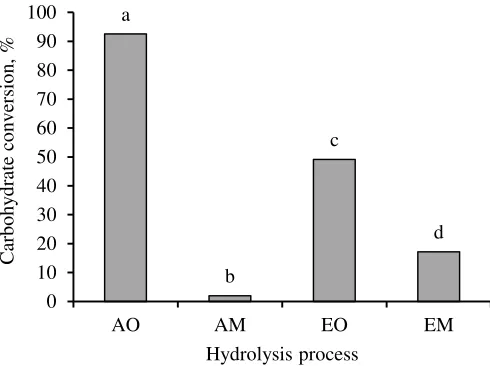Steam and Microwave Pretreatments in the Preparation of Bioethanol
from Sugar Palm Kernel
Nyoman J Wistara*, Martua YS Nababan, Rahmi N Hidayah
Department of Forest Products, Faculty of Forestry, Bogor Agricultural University, Jl. Raya Dramaga Bogor 16680.
*Corresponding author: nyomanwis@gmail.com
Abstrak
Daging buah aren adalah bahan berkarbohidrat yang dapat digunakan sebagai bahan baku bioetanol. Dalam penelitian ini, produksi bioethanol dari daging buah arena dilakukan melalui hidrolisis asam dan ensimatis dengan praperlakuan pemanasan autoclave dan microwave. Fermentasi gula pereduksi dilakukan menggunakan Saccharomyces cerevisiae pada konsentrasi 3, 10, dan 17% selama 24, 48, dan 72 jam. Hidrolisis asam dengan pemanasan otoklaf adalah perlakuan paling efisien, dengan efisiensi hidrolisis sebesar 92,52%. hidrolisis enzim dengan pemanasan autoclave dan fermentasi dengan S. cerevisiae 17% selama 24 jam menghasilkan efisiensi fermentasi sebesar 97,36%. Namun rendemen etanol tertinggi diperoleh dari hidrolisis asam dengan pemanasan autoclave dan fermentasi menggunakan S. cerevisiae 17% selama 72 jam, yaitu sebesar 76,49%.
Kata kunci: Bioetanol, daging buah aren, fermentasi, hidrolisis, S. cerevisiae.
Abstract
It is paramount to develop bioethanol production based on the utilization of less important carbohydrate based feedstock such as the sugar palm kernel. In the present works, the kernel powder of sugar palm was hydrolyzed by enzymatic and acidic procedures heated either by autoclaving or microwaving. Fermentation of the resulting reducing sugars was then carried out by Saccharomyces cerevisiae at the concentration of 3, 10, and 17% for 24, 48, and 72 hours. It was found that the highest hydrolysis efficiency was by autoclaved acid hydrolysis (92.52%). On the other hand, the highest fermentation efficiency was obtained by 24 hours fermentation with a 17% S. cerevisiae of the resulting sugar from autoclaved enzymatic hydrolysis (97.36%), and the highest ethanol yield was obtained from autoclaved acid hydrolysis fermented for 72 hours with 17% S. cerevisiae (76.49%).
Keywords: bioethanol, fermentation, hydrolysis, S. cerevisiae, sugar palm kernel Introduction
Sugar palm is a versatile palm species useful for the raw material of various products such as sugar, starch, and black strong stem fibers. It starts producing these products at approximately 5 years old with productive duration of about 5-8 years (Dinhut Prov Jateng 2010). Sugar palm is also considered as palm species with conservation value due to its rooting
system is capable of storing water and preventing soil erosion.
Autoclave and Microwave Pretreatments in the Preparation of Bioethanol from Sugar Palm Kernel 2
Martua YS Nababan, Rahmi N Hidayah, Nyoman J Wistara
carbohydrate is easier than that of cellulose. However, carbohydrate from different sources might have different characteristics requiring different hydrolysis conditions.
Convesional enzymatic hydrolysis requires high enzyme loading, prolonged retention time, and resulting in a low ethanol yield (Nitayavardhana et al. 2009). These authors have improved ethanol fermentation of cassava by ultrasonication treatment. The same pretreatment along with microwaving was also successfully applied to improve ethanol production from corn (Nikolic et al. 2010) and sago starch (Saifuddin & Hussain 2011). The present research was aimed to determine the ethanol productivity of sugar palm kernel. The influence of autoclaving and microwave pretreatment on the raw material before acid and enzymatic hydrolysis process was studied.
Methods
Sugar palm kernel preparation
Mature sugar palm kernel of 2 years old was peeled and sliced before milling into 40 – 60 mesh sugar palm kernel meal. Carbohydrate content of the meal was determined following the Luff Schrool method. The sugar palm kernel meal was made into solution in 3% HCl and boiled for 3 hours. The boiled solution was neutralized with 30% NaOH and sufficient PP indicator was added. A 10 ml of the solution was transferred into a 100 ml Erlenmeyer flask added with 25 ml Luff solution and heated for 10 mnt. After the solution was cooled down, 15 ml of 20% KI and 25 ml of H2SO4 was added. The solution was then titrated with 0.1 N Na-thiosulfate solutions. At the end of titration point, sufficient 0.5% starch indicator was added. Titration of
blank solution was also carried out to be used in the calculation of the carbohydrate content.
Glucose content was determined based on a conversion table from the difference between the amount of Na-thiosulfate needed for titration of the sample solution and that of the blank. The value of glucose content was then used to calculate the carbohydrate content of sugar palm kernel.
Hydrolysis and fermentation
Acid and enzymatic hydrolysis was applied during the preparation of simple sugar in this experiment. In enzymatic hydrolysis, sugar palm kernel meal was diluted in a 50 mM phosphate buffer to form a solution of 10% concentration (w/w, oven dried) following the method used by Shanavas et al. (2011) and Saifuddin & Hussain (2011). The solution was adjusted to pH 6 and autoclaved at 121 ⁰C for 30 min. Microwave treatment of the solution was carried out at 50% power (500 watt) for 3 min with microwave Sharp type R-348. The solution was then added with amylase at 144 U g-1 concentrations and incubated in a waterbath shaker at 80 oC for 3 hours. Before glucoamylase of 6 U g-1 concentrations was added, the solution was cooled down to 50 oC and the pH was adjusted to 5. After glucoamylase addition, the solution was incubated for 48 hours.
experiment. The 4 pretreatments included acid hydrolysis –autoclaved (AO), acid hydrolysis–microwaved (AM), enzymatic hydrolysis–autoclaved (EO), and enzymatic hydrolysis– microwaved (EM).
The filtrate of hydrolysis was adjusted to the pH of 5.5 with NaOH, and then as much as 50 ml of each sample was replaced to reaction tubes for fermentation with yeast (Saccharomyces cerevisiae). NPK (0.04%, w/v) and ZA (0.15%, w/v) were added for the nutrition of yeast growth. Before the yeast addition, the media was sterilized by autoclaving. The concentration of yeast addition was varied at 3, 10, and 17 % (v/v) carried out in a steril laminar flow. Retention time of fermentation was varied for 24, 48, and 72 hours in a shaker batch at room temperature. After the predetermined incubation period, the media was heated in boiling water for 5 min to stop further fermentation by the yeast. The media was then stred in refrigerator of 0–4 oC.
Determination of reducing sugar and ethanol yield
Reducing sugar concentration was determined by DNS method using spectrophotometer at the wave length of 540 nm and ethanol concentration was measured with gas chromatography (GC) method. As much as 1 l sample was
injected into GC-2014 Shimadzu AOC-20i (Japan) that equipped with concentration was determined based on a standard curve prepared with ethanol concentration of 0.0, 0.02, 0.04, 0.06, 0.1, 0.2, 0.5, 0.8, and 1.2% (v/v) as depicted in Fig. 1.
Figure 1 Standard curve for the determination of ethanol concentration.
RTX Wax coulum operated at 150 oC, injector temperature of 180 oC, detector temperature of 200 oC and injection pressure of 84.6 kPa with column flow of 0.65 ml min-1 and total flow of 55.5 ml min-1. Ethanol was detected at 3.3–3.5 min retention time. Ethanol based on the above mentioned analysis, hydrolysis efficiency, fermentation efficiency, and theoretical ethanol yield was calculated following the respective formulae:
( ( ) ⁄ ) or
( ( ) ⁄ ) y = 1,668x - 0,0296
R² = 0,9958
-0,1 0 0,1 0,2 0,3 0,4 0,5 0,6 0,7 0,8 0,9
0 0,2 0,4 0,6
A
b
so
rb
an
ce
,
n
m
Autoclave and Microwave Pretreatments in the Preparation of Bioethanol from Sugar Palm Kernel 4 Martua YS Nababan, Rahmi N Hidayah, Nyoman J Wistara
(A = glucose resulted from hydrolysis (g kg-1 of
carbohydrate; B = theoretical amount of the
resulted glucose (g kg-1 of carbohydrate; C = the
amount of glucose before fermentation; D = the amount of glucose after fermentation; 1.111 =
glucose conversion factor; 0.51= ethanol
conversion factor; 0.789 g ml-1 = ethanol
density).
Data analysis
Data of reducing sugar, ethanol content, ethanol yield, and starch conversion into ethanol were analyzed using SPSS 16.0 for Windows (trial version) with Duncan multiple range test. Ethanol yield data were analyzed using blocked factorial design with 2 replications.
Results and Discussion
Total content of carbohydrate in sugar palm kernel was 45.40% (w/w, oven dried). This result is higher than that found by Yasni (1982), i.e. of 32.38% (w/w, oven dried). It seemed that carbohydrate content is dependent on the measuerement method, sugar palm kernel maturity, and its growing site. Old and young sugar palm fruit retain a similar visual appearance. However, old sugar palm kernel is dense, white in color, and very hard with lower moisture content (approximately of 62%) compared to that of young sugar palm kernel (approximately of 97%). The yield of its kernel was only of 14% from its processed fruits.
Enzyme characteristics
Enzyme is a specific catalyst capable of degrading specific material. In he present works, sugar palm kernel was hydrolyzed with amylase and glucoamylase. Amylase is only capable of randomly degrading the linear chain of carbohydrate into shorter fragment, and this shorter fragment is then end peeled by glucoamylase into glucose.
Based on the activity evaluation on standard starch, optimum temperature activity of presently used amylase was at 80 oC and pH of 6 with enzyme activity of 152.58 U ml-1 (Fig. 2). Optimum temperature activity for the same type of enzyme evaluated by Kolusheva dan Marinova (2007) was at 90 oC and the pH 7. Optimum temperature activity of present glucoamylase was at 50 oC and pH 5 with enzyme activity of 42.60 U ml-1. Naiola (2006) and Risnoyatiningsih (2011) found similar activity conditions, i.e. at 40-60 oC and pH 4-6. The activity of presently used enzyme can be considered low compared to most commonly use by other researchers. This low enzyme activity might be due to that the presently used enzyme is a technical grade enzyme.
Enzyme performance on a material is dependent on carbohydrate concentration and chemical composition of other compounds. Therefore, determination of optimum enzyme concentration, temperature and operating pH to digest a material is important. It was found that optimum concentration of enzyme to digest sugar palm carbohydrate was at 144 and 6 U g-1, respectively for amylase and glukoamilase. Fig. 3 indicates the hydrolysis efficiency of the presently used amylase and glucoamylase. These optimum enzyme concentration was then used in hydrolysis to optimize reducing sugar yield.
Hydrolysis efficiency
(a) (b)
Figure 2 Optimum temperature (a) and pH (b) for optimum enzyme activity.
(a) (b) efficient with 92.52% of starch converted into glucose (Fig. 4). This method was much more efficient than acid hydrolysis with microwave heating that converted only 2.01% starch into glucose. Hydrolysis efficiency of all hydrolysis methods currently applied were significantly difference at 5% confidence level. Furthermore, Duncan multiple range test indicated that the hydrolysis efficiency of each methods were also different.
The presence of other carbohydrate types could be the cause of low carbohydrate conversion in EO and EM hydrolysis methods. Retention time and temperature of microwaving could be also influence the low carbohydrate conversion in AM method. Retention time in microwave heating might be too short, since heating process was taking place simultaneously with carbohydrate fragmentation. In this case, the carbohydrate has not been cleaved into glucose yet. Increasing acid concentration is not an appropriate choice because of increasing acid concentration during hydrolysis did not influence reducing sugar yield (Hashem & Darwish 2010).
Enzyme concentration, U g-1
Autoclave and Microwave Pretreatments in the Preparation of Bioethanol from Sugar Palm Kernel 6 Martua YS Nababan, Rahmi N Hidayah, Nyoman J Wistara
Figure 4 Carbohydrate conversion into glucose (hydrolysis efficiency) in acid and enzymatic hydrolysis heated in autoclave and microwave oven.
Fermentation eficiency
Fermentation efficiency was significantly influenced by hydrolysis methods and duration of fermentation ( = 95%). Since yeast concentration did not influence fermentation efficiency, fermentation should be done with 3% yeast concentration. This will reduce the cost of fermentation. Fermentation of reducing sugar produced from EO hydrolysis with 17% S. cerevisiae for 24 h incubation time resulted ini an efficiency of 97.36%. This was the highest fermentation efficiency achieved in the present works. Fermentation for 24 h was concluded capable of producing maximum ethanol concentration and tends to decrease afterward (Hashem & Darwish 2010). However, based on Duncan multiple range test, the most efficient fermentation was using EO for 48 h fermentation time (Fig. 5). In average, fermentation efficiency of EO was approximately of 96%.
Hydrolysis efficieny was not in accordance with the fermentation efficiency. AO hydrolysis was the most efficient (Fig. 4), but the most efficient
fermentation of hydrolysis result was for the EO hydrolysis method (Fig. 5). Relatively high ethanol concentration can be formed during fermentation at high reducing sugar concentration, and this could disturb the capability of S. cerevisiae yeast to proceed the fermentation (Stanley et al. 2010, Kasavi et al. 2012). Another common case is that fermentation of the resulted reducing sugar is hampered by the formation of inhibitor compounds such as hydroxymethyl furfural (HMF), furfural, and acetic acid (Fatriasari et al. 2014). The inhibitor compounds are mostly formed in acid hydrolysis.
Ethanol yield
Bioethanol production processes can be evaluated from its ethanol yield. Hydrolysis methods and fermentation duration significantly influenced ethanol yield. Figure 6 indicates the influence of hydrolysis methods and fermentation duration on ethanol yield. AO hydrolysis fermented with 17% yeast for 72 h resulted in the highest ethanol yield (76.5% based on carbohydrate content or 34.7% based on initial biomass).
(a) (b)
Figure 5 The effect of hydrolysis methods (a) and fermentation time (b) on fermentation efficiency of sugar palm kernel.
(a) (b)
Figure 6 The effect of hydrolysis methods (a) and fermentation time (b) on ethanol yield of sugar palm kernel.
High fermentation efficiency was not followed by high ethanol yield. The Thus, considering the moisture content of the kernel (approximately of 62%), 8.3 l ethanol can be produced from every harvest of a sugar palm tree.
Conclusions
Autoclave and Microwave Pretreatments in the Preparation of Bioethanol from Sugar Palm Kernel 8 Martua YS Nababan, Rahmi N Hidayah, Nyoman J Wistara
References
Demirbas T, Demirbas AH. 2010. Bioenergy, green energy, biomass and biofuels. Energy Sources Part A. 32:1067-1075.
[Dihut Prov Jateng] Dinas Kehutanan Provinsi Jawa Tengah. 2010. Budidaya dan pengembangan tanaman aren.
http://epetani.deptan.go.id/budidaya/b udidaya-dan-pengembangan-tanaman-aren-3703. [12 Mei 2012].
Fatriasari W, Syafii W, Wistara NJ, Syamsu K, Prasetya B. 2014. Digestibility of betung bamboo fiber following fungal pretreatment. Makara J Technol. 18(2):51-58.
Hashem M, Darwish SMI. 2010. Production of bioethanol and associated by-products from potato starch residue stream by Saccharomyces cerevisiae. Biomass Bioenergy 34:953-959.
Kasavi C, Finore I, Lama L, Nicolaus B, Oliver SG, Oner ET, Kirdar B. 2012.
Evaluation of industrial
Saccharomyces cerevisiae strains for ethanol production from biomass. Biomass Bioenergy 45:230-238.
Kolusheva T, Marinova A. 2007. A study the optimal conditions for starch hydrolysis through thermostable α -amylase. J Univ Technol Metallurg. 42 (1):93-96.
Naiola E. 2006. Karakterisasi enzim kasar glukoamilase dari Saccharo mycopsis sp. [Characterization of crude glucoamylase from Saccharo mycopsis sp.]. Ber Biol. 8(3):187-192.
Nikolic S, Mojovic L, Rakin M, Dusanka P, Pejin J. 2010. Ultrasound-assisted production of bioethanol by
simultaneous saccharification and fermentation of corn meal. Food Chem. 122:216-222.
Nitayavardhana S, Shrestha P, Rasmussen ML, Lamsal BP, Leeuwen JHV, Khanal SK. 2009. Ultrasound improved ethanol fermentation from cassava chips in cassava-based ethanol plants. Bioresour Technol. 101:2741-2747.
Risnoyatiningsih S. 2011. Hydrolysis of starch saccharides from sweet potatoes using enzyme (Hidrolisis pati ubi jalar kuning menjadi glukosa secara enzimatis). J Tek Kim. 5 (2):417-424.
Saifuddin N, Hussain R. 2011. Microwave assisted bioethanol production from sago starch by co-culturing of ragi tapai and saccharomyces cerevisiae. J Math Stat. 7(3):198-206.
Shanavas S, Padmaja G, Moorthy SN, Sajeev MS, Sheriff JT. 2011. Process optimization for bioethanol production from cassava starch using novel eco-friendly enzymes. Biomass Bioenergy 35:901-909.
Stanley D, Bandara A, Fraser S, Chambers PJ, Stanley GA. 2010. The ethanol stress response and ethanol tolerance of Sacchaomyces cerevisiae. J Appl Microbiol. 109:13-14.
Yasni S. 1982. Pembuatan manisan kolang-kaling (Arenga pinnata Merr) dengan kemasan dalam botol [skripsi]. Bogor: Institut Pertanian Bogor.
Riwayat naskah



